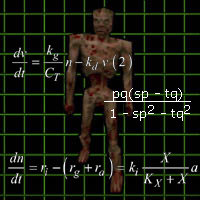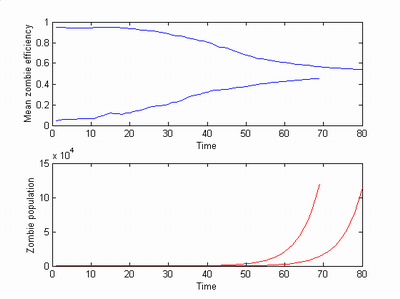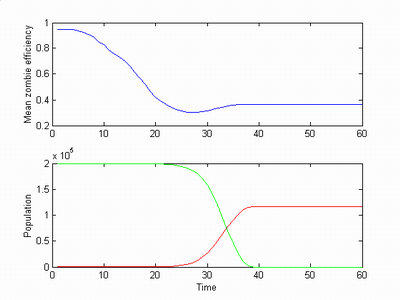January 10, 2007
Zombie evolutionary epidemiology
 Normally I loathe zombie stories. But the excellent Dinosaur Comics brings up zombie epidemiology. Fast-moving, efficient zombies ought to be good at eating their victims, resulting in just the initial zombies and nobody else in the vicinity. Inefficient slow zombies might just be able to bite their victims and hence produce more zombies, but they are unlikely to be able to spread since they are bad at catching anyone. Ergo, no risk of zombie epidemics.
Normally I loathe zombie stories. But the excellent Dinosaur Comics brings up zombie epidemiology. Fast-moving, efficient zombies ought to be good at eating their victims, resulting in just the initial zombies and nobody else in the vicinity. Inefficient slow zombies might just be able to bite their victims and hence produce more zombies, but they are unlikely to be able to spread since they are bad at catching anyone. Ergo, no risk of zombie epidemics.
I think Rex is making a mistake in his reasoning. First, there is of course always a slight chance of incompetence from efficient zombies and competence from inefficient zombies. This will lead to growth in any case.
Second, there might also be an evolutionary pressure on zombies. Assuming zombieness is in some sense heritable (why not? nothing about zombies makes sense anyway), there would be an evolution towards reduced virulence (i.e. biting, not killing as often). This is just as how many non-vector transmitted diseases evolve towards more benign forms where the host is not killed (diseases transmitted by vectors on the other hand have a weaker incentive to become less virulent). So the initial zombies would evolve towards an optimal speed to injure enough people to keep the spreading high, but not be too efficient. Maybe this is the "Hollywood optimum", since it provides with maximum uncertainty of the survival of the heroes.
I did a little simulation of this. Zombies start out with uniformly distributed efficiencies. Each turn a zombie has a chance of catching a human equal to its efficiency. If that happens there is another chance equal to 1-efficiency that the human is not eaten but instead becomes a zombie with efficiency equal to its "parent" plus a normally distributed change with standard deviation 0.1. The simulation continues until there are 100,000 zombies from the initial population of 10.

Both an efficient population and an inefficient evolve towards the "optimal" efficiency of 0.5. The population curves are exponential, but due to initial luck different zombie infestations may take a different amount of time before exploding.
Plotting the distribution of efficiency shows a nice evolution towards a normal distribution (with two deltas at the ends due to me keeping efficiencies above 0 and below 1 artificially).

Zombies actually evolve towards a very diverse population, with some zombies very fast and some very slow even if the majority is optimal. This might be relevant as the situation changes. If there are many people around the optimal efficiency is lower than 0.5, since each zombie still has plenty of chances of attacking someone. After most people have turned to zombies fast zombies have more fitness (pun not intended) since they are better at getting the few survivors.
Adding this to the simulation in the form of having the capture probability be proportional to efficiency*sqrt(humans/zombies) I got the following result (humans in green):

At first the very fast zombies expand, evolving towards ever more shuffling zombies while the humans are plentiful. Once the human population starts to decrease appreciably the zombies begins to evolve towards faster zombies again. But now there are so few humans left that the plentiful old zombies get them anyway and the evolution stops before it gets very far.
Next week: coalescent theory and vampire lineages.